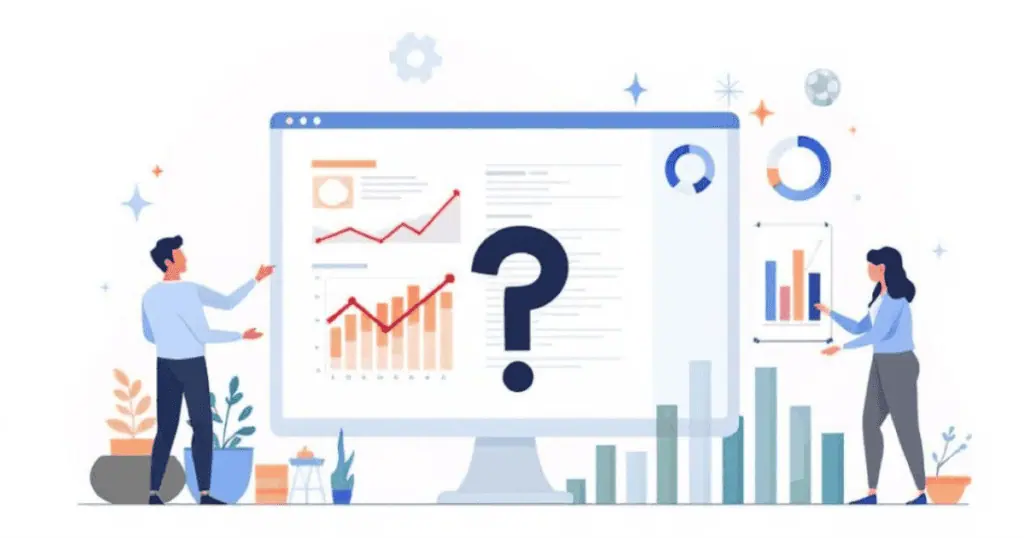Data Analysis and Business Intelligence: What Are You Missing?

Written By:
Last Updated Date:
Hey there, fellow small business owners! Today, we’re exploring data analysis and business intelligence (BI), which have revolutionized my business.
Don’t let these terms intimidate you. By the end of this guide, you’ll see how data analysis and business intelligence can transform your small business.
There is a study by Dresner Advisory Services found that 48% of organizations use business intelligence tools to drive strategic decision-making.
Adopting business intelligence tools for your business is so important. You can reap many benefits, such as improved operational efficiency, more revenue, more advantages, and more!
Whether you’re just starting or looking to level up, understanding and implementing data analysis and BI can give you a severe edge in today’s data-driven world.
Key Takeaways
- Data-Driven Decisions: Leveraging data analysis helps small businesses make smarter choices, compete with larger companies, and uncover growth opportunities.
- Affordable Start: Begin with low-cost tools like Excel or Google Sheets, then progress to advanced solutions as needed. This approach makes data analysis accessible to businesses of all sizes.
- Culture and Practices: Build a data-driven culture, focus on key performance indicators, and follow data management best practices to effectively use insights for improvement.
Understanding Data Analysis and Business Intelligence

When you start your small business, you may be flying blind. Sure, you had a general idea of how things were going, but maybe most of it was guesswork. Looking for a solution, I can introduce you to the world of data analysis and business intelligence so that everything can change and improve.
Data analysis is like being a detective for your business. You’re looking at all the information your company generates and making sense of it. This could be anything from sales figures and customer demographics to website traffic and social media engagement. By analyzing this data, you can uncover patterns, trends, and insights that might not be obvious at first glance.
Business intelligence takes it a step further. Using that analysis, we can make smarter decisions and predict future trends. BI tools can help you visualize your data, create reports, and get alerts when specific metrics change.
Differences Between Data Analysis and Business Intelligence

Think of data analysis as looking in the rearview mirror to understand where you’ve been, while business intelligence is like using GPS to plan your route forward. Both are crucial for successfully navigating your business journey.
Data analysis is more about understanding what happened in the past. It’s descriptive and diagnostic, telling you what occurred and why. Business intelligence, on the other hand, is more forward-looking. It’s about using that historical data to predict and guide future decisions.
The Importance of Data Analysis and BI for Small Businesses
For small businesses, data analysis and BI are absolute gold. We don’t have the resources to make expensive mistakes or miss out on opportunities. Data-driven decision-making can help you compete with the big guys by being smarter and more efficient.
Data analysis is about showing you what’s happening, not just what you think is happening.
Data analysis and BI can help you in numerous ways:
- Identify new opportunities: You might discover an untapped market segment or a product feature customers love.
- Improve customer satisfaction: By analyzing customer feedback and behavior, you can tailor your offerings to better meet their needs.
- Optimize operations: From inventory management to employee scheduling, data can help you run your business more efficiently.
- Make more accurate forecasts: Data-driven forecasts are typically more reliable than gut feelings for sales projections or budget planning.
Essential Data Analysis Tools for Small Businesses

Now, let’s talk tools. When you first start, you may think you need expensive tools and plan a big budget for them. But I’ll make it simple. There are tons of affordable (and even free) tools for small businesses.
- Spreadsheets: Microsoft Excel and Google Sheets are powerhouses for data analysis. Learning pivot tables is a game-changer for any small business. These tools are great for organizing data, performing calculations, and creating basic visualizations.
- Visualization Tools: Tableau Public and Google Data Studio can turn your data into eye-catching, insightful visuals. These tools make creating interactive dashboards and reports easy for non-design experts.
- Business Intelligence Platforms: Tools like Power BI, Looker, or Sisense offer more comprehensive BI capabilities. They can connect to various data sources, provide advanced visualizations, and offer features like predictive analytics.
Affordable and User-Friendly Data Analysis Software
Start with familiar tools like Excel or Google Sheets. Explore options like Power BI or Zoho Analytics as your employees get more comfortable. These offer more advanced features but still have a relatively gentle learning curve.
The key is to start small and gradually build your skills. Remember, the best tool is the one you’ll use. Don’t get caught up in fancy features if they’re irrelevant to your business needs. Focus on tools that provide the insights you need to make better decisions.
Implementing Business Intelligence in Your Small Business

Okay, you’ve got your tools, and you’re starting to make sense of your data. Now what? It’s time to implement business intelligence in your small business. This is where the rubber meets the road, folks.
Creating a data-driven culture and identifying key performance indicators (KPIs) are crucial. These are the metrics that matter for your business.
It isn’t just about total sales, customer lifetime value, conversion rates, and acquisition costs. Once you know what to focus on, it becomes much easier to make decisions.
Setting up dashboards is also important. You use a mix of Google Data Studio and Tableau to track our KPIs in real time. This allows you to see how things are going at a glance and spot any issues before they become big problems.
Best Practices for Data Collection and Management
Now, let’s talk about data collection and management. This might not sound fascinating, but trust me, it’s crucial. Garbage in, garbage out, as they say. I learned this hard when I realized we’d collected inaccurate data for months. What a headache!
Start by identifying what data you need. Don’t go overboard – focus on what’s truly important for your business. Then, systems will be set up to collect this data consistently and accurately. This might mean training your team or investing in some automation tools.
Here are some best practices for data collection and management:
- Standardize data entry: Ensure everyone enters data in the same format to avoid confusion.
- Regularly back up your data: Don’t risk losing all your valuable information.
- Implement data validation: Set up checks to catch obvious errors in data entry.
- Document your processes: Make sure everyone knows how data should be collected and managed.
- Stay compliant: Be aware of data privacy laws and handle customer data appropriately.
Practical Applications of Data Analysis in Small Business Operations

Let’s get into how data analysis can help your small business. This isn’t just theoretical stuff; these are real-world applications that can make a big difference in your bottom line.
- Customer Segmentation and Targeted Marketing: It’s like wearing glasses for the first time. But then, everything will be so much clearer! You shouldn’t treat all customers the same way. Everyone has different behaviors and needs. By focusing on these segments, you’ll see a high conversion rate.
- Inventory Management: You may struggle if there is too much stock (tying up cash) or running out of popular items (losing sales). But the good news is that by analyzing sales data and using some basic forecasting techniques, You’ll be able to optimize inventory levels. It’s not perfect. There’s always an element of unpredictability in business. But it will be a whole lot better than before.
- Financial Analysis and Budgeting: You can create a dashboard that shows your key financial metrics, such as cash flow, profit margins, and expenses by category. This will make budgeting much easier and help you spot potential issues before they become real problems.
Overcoming Common Challenges in Data Analysis for Small Businesses
Implementing data analysis in a small business isn’t all sunshine and rainbows. There are challenges, and I’ve faced my fair share of them.
Some challenges include limited resources and budget constraints, data quality issues, and a lack of expertise. To keep things moving, start by using free or low-cost tools.
Also, it’s crucial to ensure data accuracy and up-to-date. This means training your team consistently, setting validation checks, or regulatory auditing your data.
Addressing Data Privacy and Security Concerns
Let’s talk about the elephant in the room, data privacy and security. This stuff can keep you up at night. You may think you’re not a target for data breaches, but that’s not true. It would be best if you protect your business as you’re protecting an asset.
Start by educating yourself and your team about data privacy laws and best practices. Make sure you’re only collecting the data you need and storing it securely. And please use strong passwords and two-factor authentication. It’s a small step that can save you from a world of hurt.
Future Trends in Data Analysis and Business Intelligence
Okay, it’s time to put on our futurist hats and discuss what’s next in the world of data analysis and business intelligence for small businesses.
- Artificial Intelligence and Machine Learning: AI isn’t just for tech giants anymore. AI tools to help with customer service chatbots, predictive analytics, and more exist. It’s worth keeping an eye on this space.
- Predictive Analytics involves using historical data to predict future trends. It’s better than just guessing. As these tools become more accessible to small businesses, they could be game-changers.
- Real-time Analytics: Analyzing data as it arrives rather than in batches is becoming more important. This can help you respond quickly to changes in your business environment.
Wrapping up
Data analysis and business intelligence aren’t just a trend but a powerful tool for any business to compete in an increasingly data-driven world. It might seem daunting at first, but trust me, the payoff is worth it.
Remember, you don’t have to do everything at once. Start small, focus on the most important data for your business, and gradually build your capabilities. Stay curious, don’t be afraid to make mistakes, and always be looking for ways to use data to improve your business.
Every big business started as a small one. With the right data and insights, who knows where your business could go? So roll up your sleeves, dig into your data, and see what insights we can uncover. The future of your business might just be hiding in those numbers!
Frequently Asked Questions (FAQ)
I’m a Data Enthusiast and Content Writer with a passion for helping people improve their lives through data analysis. I’m a self taught programmer and has a strong interest in artificial intelligence and natural language processing. I’m always learning and looking for new ways to use data to solve problems and improve businesses.






